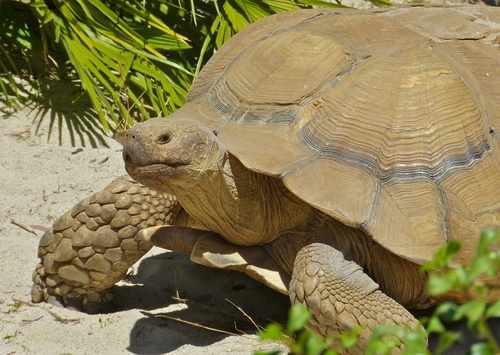
African spurred tortoise
The African spurred tortoise, Centrochelys sulcata, thrives in the harsh Sahara, boasting a massive, spurred shell and remarkable burrowing skills. Its resilience and unique adaptations make it a fascinating desert survivor, contributing significantly to the ecosystem by aerating the soil and dispersing seeds.
70 years
Lifespan
35.8349 - 90.7185 kg
Weight
Length: 76 cm
Size
Brown, Yellow
Color
15 years
Age of Sexual Maturity
0.3 mph
Top Speed
Endangered
Conservation Status
Decreasing
Population Trend
Characteristics
Centrochelys sulcata, commonly known as the African spurred tortoise, is the third-largest tortoise species in the world. Native to the southern edge of the Sahara Desert, it has a remarkable ability to withstand arid conditions. This tortoise is known for its distinctive spurred legs, large domed shell, and herbivorous diet. They are known for burrowing to escape the heat, creating intricate tunnels.
Distribution Range of the African spurred tortoise
Centrochelys sulcata, commonly known as the African spurred tortoise, is native to the southern edge of the Sahara Desert in Africa. Its geographical distribution includes countries such as Mauritania, Mali, Chad, Sudan, Niger, Burkina Faso, and Senegal.
African spurred tortoise's Habitat
Environmental Conditions
The African spurred tortoise typically inhabits arid and semi-arid regions characterized by savanna, scrubland, and desert environments. The climate in these areas is hot and dry with minimal rainfall, and the landscape often includes sparse vegetation.
Ecological Niche
Centrochelys sulcata occupies an ecological niche as a herbivore, feeding on grasses, succulents, and other vegetation adapted to arid environments. The tortoise is well-adapted to survive in harsh desert conditions, with behaviors such as burrowing to escape extreme temperatures and conserve moisture.
Copyright @ Nature Style Limited. All Rights Reserved.
 English
English